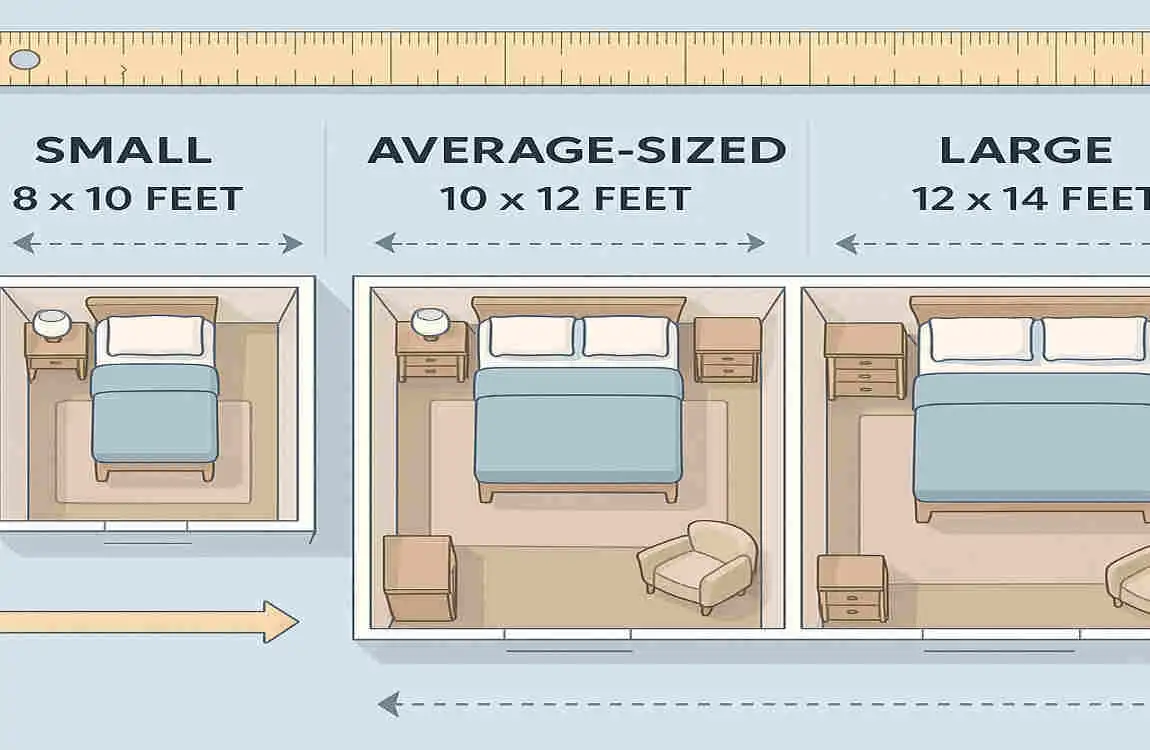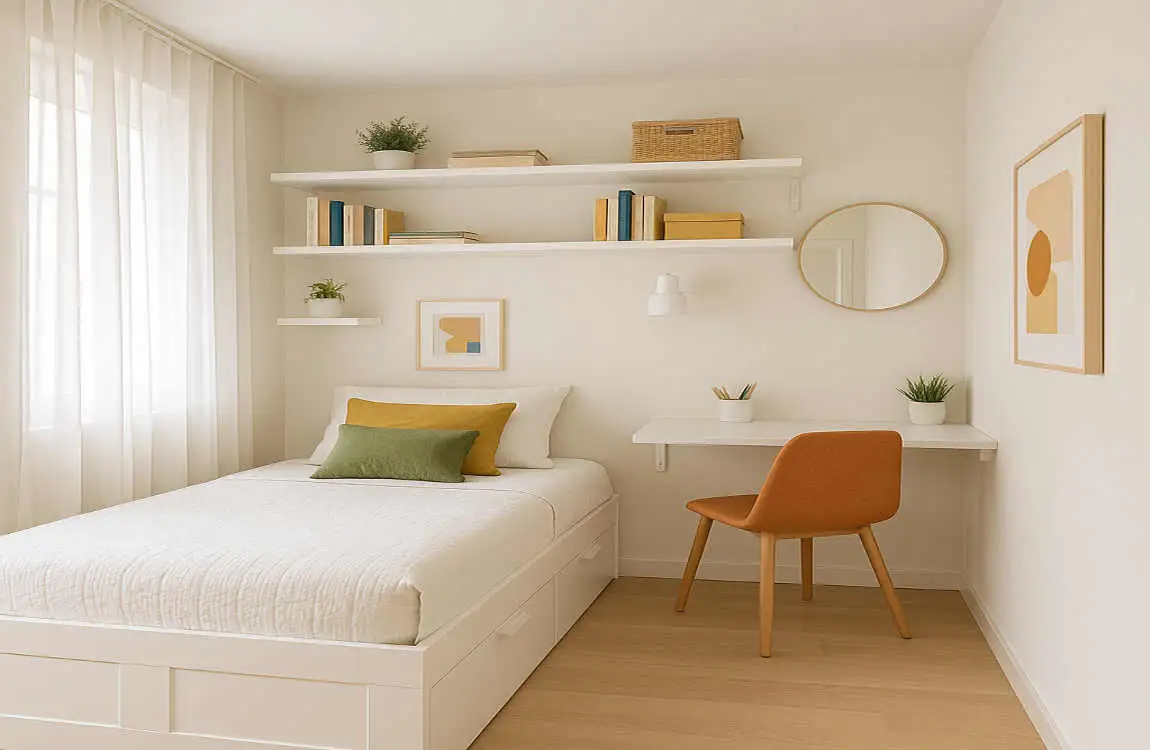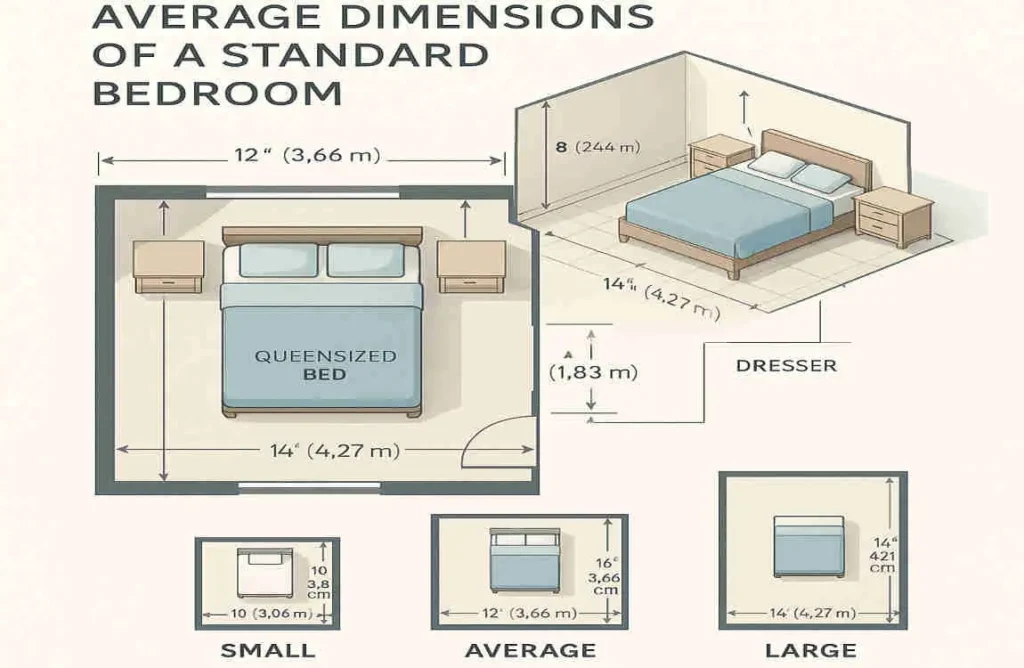Have you ever wondered how big an average bedroom is? It’s a question many of us ask when planning our living spaces. The size of your bedroom can make a huge difference in how comfortable and functional your home feels.
We’ll start by defining what we mean by “average” when it comes to bedroom sizes. Next, we’ll examine typical dimensions for bedrooms in various contexts, ranging from apartments to houses worldwide.
Understanding Bedroom Sizes: What Does “Average” Mean?

When we talk about bedroom sizes, it’s important to understand that “average” can mean different things depending on the context. Let’s break it down:
Defining Bedroom Size Variations
- Small bedroom: Typically ranges from 7×9 feet to 9×11 feet
- Average bedroom: Usually falls between 10×12 feet and 12×14 feet
- Main bedroom: Often larger than 14×16 feet, sometimes much larger
Factors Influencing Bedroom Size
Several factors can influence the size of a bedroom:
- Home type: Bedrooms in apartments tend to be smaller than those in houses
- Region: Bedroom sizes can vary significantly between countries and even within different areas of the same country
- Building codes: Local building codes and regulations may dictate minimum bedroom sizes
National and International Standards for Bedroom Dimensions
While there’s no universal standard for bedroom sizes, many countries have established guidelines:
- In the United States, the International Residential Code (IRC) requires bedrooms to have a minimum of 70 square feet of floor space.
- In the United Kingdom, the minimum bedroom size is 6.5 square meters (about 70 square feet)
- In Australia, the National Construction Code (NCC) sets a minimum of 6 square meters (about 65 square feet) for bedrooms.
How Big Is an Average Bedroom?
Now that we’ve established what “average” means in the context of bedroom sizes, let’s look at some typical dimensions:
Standard Bedroom Size
The most common bedroom size in many countries falls between 10×12 feet and 12×14 feet. This provides sufficient space for a standard double bed, storage, and a small area for walking.
Average Bedroom Size in Apartments vs Houses
- Apartments: Due to space constraints, bedrooms in apartments tend to be on the smaller side, often ranging from 10×10 feet to 12×12 feet
- Houses: Bedrooms in dwellings can be larger, with many falling between 12×12 feet and 14×16 feet, especially for master bedrooms
Average Bedroom Sizes Around the World
Let’s take a look at some average bedroom sizes in different countries:
- United States: 12×12 feet to 14×16 feet
- United Kingdom: 10×10 feet to 12×12 feet
- Europe: Varies widely, but often between 10×10 feet and 14×14 feet.
- Asia: Can be smaller, with some countries averaging 8×8 feet to 10×10 feet
Remember, these are just averages, and bedroom sizes can vary significantly within each country and region.
Essential Room Size Requirements for Comfort and Functionality
To create a comfortable and functional bedroom, you need to consider more than just the overall size of the room. Here are some essential factors to keep in mind:
Minimum Space Requirements for Bedroom Furniture
- Bed sizes: A standard double bed is 53×75 inches, while a queen is 60×80 inches, and a king is 76×80 inches
- Storage: Allow at least 2 feet of space for a dresser or wardrobe
- Walking space: Leave at least 2 feet of space around the bed for easy movement
Space Needed for Circulation
You’ll want to leave enough room to move comfortably around your bedroom. Here are some general guidelines:
- Around the bed: 2-3 feet on each side and at the foot of the bed
- Between furniture pieces: 18-24 inches between larger pieces like the bed and dresser
- To the door: Ensure a clear path to the bedroom door, ideally at least 3 feet wide
Impact of Ceiling Height and Room Shape
The height of your ceiling and the shape of your room can affect how spacious it feels:
- Ceiling height: Standard ceiling height is 8 feet, but higher ceilings can make a room feel larger
- Room shape: Square rooms tend to feel more spacious than long, narrow ones
Accessibility and Safety Considerations
When planning your bedroom size, don’t forget about accessibility and safety:
- Accessibility: Ensure there’s enough space for wheelchair access if needed, with at least 3 feet of clearance around the bed
- Safety: Keep furniture away from windows and ensure there’s a clear path to the door in case of emergency
Different Types of Bedrooms and Their Sizes
Not all bedrooms are created equal. Let’s look at some different types of bedrooms and their ideal sizes:
Master Bedroom Sizes
A main bedroom is often the largest in the house, providing ample space for a king or queen-sized bed, as well as sufficient storage and sometimes a sitting area. Typical sizes range from 14×16 feet to 20×20 feet or larger.
Guest Bedrooms
When it comes to guest bedrooms, you want to provide a comfortable space for your visitors. A good rule of thumb is to aim for at least 10×12 feet, with sufficient room for a double or queen-sized bed and some storage space.
Kids’ Bedrooms
Kids’ bedrooms can vary in size depending on the age and needs of the child:
- Young children: 8×10 feet to 10×12 feet, with space for a single bed and some play area
- Teenagers: 10×12 feet to 12×14 feet, with room for a larger bed and a desk or study area
Multi-Purpose Bedrooms
If you’re using your bedroom for more than just sleeping, you’ll need to factor in extra space:
- Home office: Add at least 6×6 feet for a desk and chair
- Exercise space: Allow 6×8 feet for a small home gym or yoga area
- Reading nook: Include a 4×4 foot area for a cozy chair and bookshelf
How to Measure Your Bedroom Size Accurately
To ensure you have the right bedroom size for your needs, it’s important to measure accurately. Here’s a step-by-step guide:
Step-by-Step Guide on Measuring a Bedroom
- Length and width: Measure the longest and widest points of the room, from wall to wall
- Height: Measure from the floor to the ceiling at multiple points to account for any variations
- Irregular shapes: If your room is not a perfect rectangle, break it down into smaller, measurable sections
Tools Needed for Accurate Measurement
- Tape measure: A long, retractable tape measure is essential for measuring larger rooms
- Laser measure: For even more accuracy, consider using a laser measure, especially for ceiling height
- Notebook and pen: Keep track of your measurements as you go
Tips on Measuring Irregularly Shaped Bedrooms
- Break it down: Divide the room into smaller, more manageable sections
- Measure at multiple points: Take measurements at different points along the walls to account for any irregularities
- Use a floor plan: Sketch a rough floor plan of your room and mark your measurements for easy reference
Tips for Making Small Bedrooms Feel Larger and More Functional

If you’re working with a smaller bedroom, don’t worry! There are plenty of ways to make it feel larger and more functional:
Smart Furniture and Storage Solutions
- Multi-functional furniture: Look for pieces that serve more than one purpose, like a bedroom built-in storage
- Vertical storage: Use tall bookshelves or cabinets to maximize storage without taking up floor space
- Under-bed storage: Utilize the space under your bed with drawers or rolling bins
Layout Strategies to Maximize Space
- Keep it simple: Avoid cluttering the room with too much furniture
- Use a focal point: Arrange your furniture around a central point, like the bed or a window
- Leave space around the bed: Ensure there’s enough room to walk around the bed comfortably
Lighting and Color Choices
- Light colors: Opt for light, neutral colors on the walls to make the room feel more spacious
- Natural light: Maximize natural light by keeping windows uncovered or using sheer curtains
- Layered lighting: Use a combination of overhead, task, and accent lighting to create a bright, inviting space
Avoiding Over-Cluttering
- Declutter regularly: Keep your bedroom tidy by regularly sorting through your belongings and getting rid of what you don’t need
- Use hidden storage: Keep clutter out of sight with storage solutions like under-bed boxes or ottomans with built-in storage
- Limit decorative items: While a few well-chosen pieces can add personality to your room, too many can make it feel cramped
Planning Your Bedroom Size in New Homes or Renovations
If you’re building a new home or renovating an existing one, you have the opportunity to plan your bedroom sizes from scratch. Here are some factors to consider:
Factors to Consider When Deciding Bedroom Sizes
- Lifestyle: Consider how you’ll use the bedroom and what furniture you’ll need
- Future needs: Think about how your needs may change over time, such as adding a home office or accommodating a growing family
- Resale value: Keep in mind that larger bedrooms may be more attractive to potential buyers
Balancing Bedroom Size Against Overall Floor Plan Efficiency
While it’s tempting to make every bedroom as large as possible, you need to balance that against the overall efficiency of your floor plan:
- Traffic flow: Ensure that the layout allows for easy movement between rooms
- Natural light: Consider how the size and placement of bedrooms will affect natural light throughout the house
- Other room sizes: Make sure your bedroom sizes don’t compromise the size and functionality of other important rooms, like the kitchen or living room
Consulting Building Codes and Zoning Rules
Before finalizing your bedroom sizes, be sure to check local building codes and zoning regulations:
- Minimum sizes: Ensure your bedrooms meet the minimum size requirements set by your local authorities
- Window and egress requirements: Make sure your bedrooms have the required number and size of windows for natural light and emergency egress
- Accessibility: If you’re planning to make your home accessible, check for any specific requirements related to bedroom size and layout
Real-Life Examples and Case Studies
To help you visualize how different bedroom sizes can work in real life, let’s look at some examples:
Examples of Different Bedroom Sizes
- Small bedroom: A 9×11-foot bedroom with a single bed, a small dresser, and a narrow desk
- Average bedroom: A 12×12 foot bedroom with a queen-sized bed, larger dresser, and space for a small sitting area
- Main bedroom: A 16×18-foot bedroom with a king-sized bed, a large walk-in closet, and a sitting area with a fireplace
